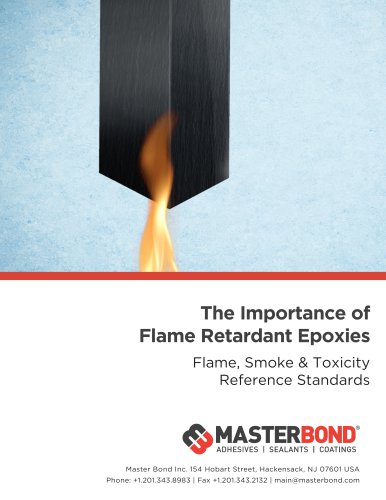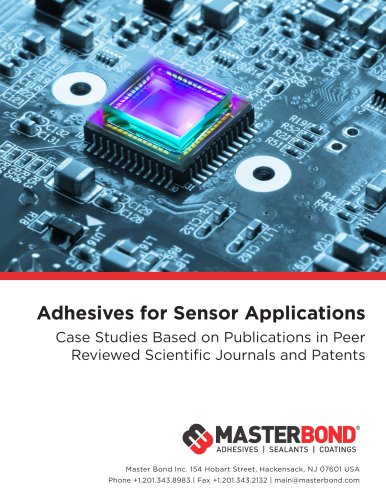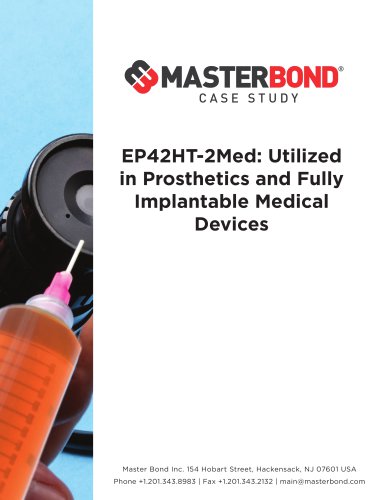 Website:
Master Bond
Website:
Master Bond
Catalog excerpts

Applications in Plasma Physics, Astronomy, Highway Engineering and More Master Bond Inc. 154 Hobart Street, Hackensack, NJ 07601 USA Phone +1.201.343.8983 | Fax +1.201.343.2132 | main@masterbond.com
Open the catalog to page 1
<$> MASTER BOND CASE STUDY Since its introduction, Master Bond EP29LPSP has been the epoxy compound of choice in a variety of challenging applications. Ideal for demanding cryogenic environments, two-part EP29LPSP can withstand temperatures as low as 4K and can resist cryogenic shock when, for instance, it is cooled from room temperature to cryogenic temperatures within a 5-10 minute window. Optically clear EP29LPSP has superior physical strength, electrical insulation, and chemical resistance properties. It also meets NASA low outgassing requirements and exhibits a low exotherm during...
Open the catalog to page 2
Plasma Physics Experimental Device At the Princeton University Plasma Physics Laboratory (PPPL), physicists and engineers have designed an experimental apparatus for studying magnetic reconnection, a physical process that drives solar flares, the Northern and Southern Lights, and other dramatic solar events.1 Through the process of magnetic reconnection, magnetic field energy is converted into enormous amounts of thermal and kinetic energy, and high energy charged particles are hurled into space at up to the speed of light. Among the key components in PPPL’s apparatus, known as the FLARE...
Open the catalog to page 3
induces small electric currents in the part of the brain just under the coil. By observing the resultant motor activity of the patient or subject, medical professionals can assess the damage from a brain injury or disorder, such as a stroke or multiple sclerosis. Scientists at Bar-Ilan University in Israel designed a study to explore exactly how magnetic stimulation acts on nerve cells in the brain.3 Thin slices of the somatosensory cortex of rats’ brains were prepared for use in the study. A common-used procedure for studying the electrical activity of neurons, known as the patch-clamp...
Open the catalog to page 4
A key component of the Princeton argon detector is a cryogenic photomultiplier tube (PMT), which had to be modified to reduce background radioactivity by replacing a glass feedthrough with a high purity ceramic plate. When the modified PMT failed high voltage tests in pure argon gas, researchers hypothesized that the source of the electric breakdown was the narrow space (~1mm) between the anode lead passing through the ceramic plate and the outer rim of the plate. Because the rim is metalized to form a seal with the metal PMT housing, and the housing shares the cathode potential, there is...
Open the catalog to page 5
Closed-system Cryogenic Refrigerator Master Bond EP29LPSP epoxy was cited in a patent granted to S2 Corporation for a cryogenic refrigerator.8 The patented device is designed to cool a sample to < 4K while isolating the sample from vibrations produced by the cooling mechanism. In a closed system cryo-cooler, a single charge of helium gas is pressure-cycled to cool the sample in a continuous refrigeration cycle. A drawback to closed system cryo-coolers is that the constant pressure-cycling transfers vibrations to the sample to be cooled, which could pose a problem for sensitive samples. The...
Open the catalog to page 6
Fiber-optic Gyroscopes Master Bond EP29LPSP epoxy adhesive was cited in two patent grants for ways to improve the performance of fiber-optic gyroscopes (FOGs) through unique designs of the fiber-optic sensing coil apparatus, which is at the heart of a FOG. In the first patent, granted to Honeywell International Inc., the sensing coil apparatus consists of an optical fiber formed into a coil and placed inside an oxygen-filled hermetically sealed chamber.11 The fiber-optic coil is held together with an adhesive, which also serves to fill gaps between the coil windings and to provide a...
Open the catalog to page 7
1 “Manufacturing Specification and Statement of Work: FLARE (Facility for Laboratory Reconnection Experiments) Project — Fabrication of Flux Core, FLARE-Spec-03-Rev.00, WP1995, Revision 0,” Princeton University Plasma Physics Laboratory, 19 Mar. 2015, flare.pppl.gov/Construction/FLARE%20FCSpec-03%2019Mar15.pdf. 2 Lee, David, et al. “Properties of optical fibres at cryogenic temperatures.” Monthly Notices of the Royal Astronomical Society, vol. 326, no. 2, 11 Sept. 2001, pp. 774-780. ResearchGate, doi: 10.1046/j.1365-8711.2001.04630.x. Accessed 2 Aug. 2017. 3 Pashut, T., et al. “Patch-clamp...
Open the catalog to page 8All Master Bond catalogs and technical brochures
-
Master_Bond-Adhesives-Sensors
10 Pages
-
EP42HT-2Med
4 Pages





